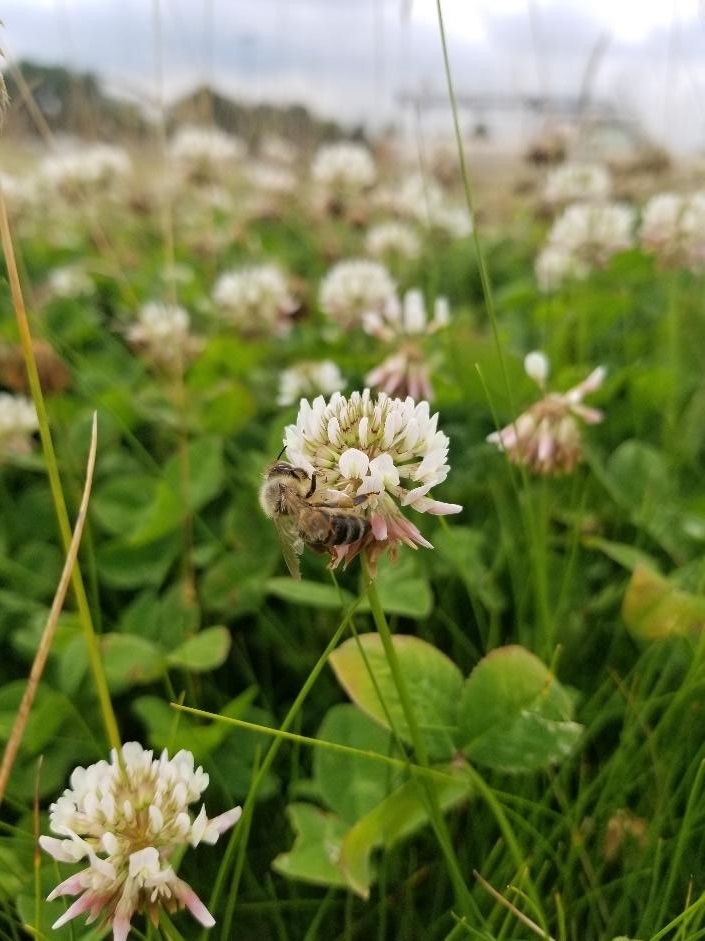By Ryan Schwab
“No-mow” is a loose term we often use to describe a low input, grassy area that grows out higher than a typical turfgrass stand. The grass may flop over onto itself, go to seed, or create a clumpy pasture-like appearance (Figure 1). In Minnesota, fine fescues (Festuca spp.) are typically used in no-mow residential lawns or golf course roughs. Despite the term “no-mow” these may be mowed infrequently to create the desired aesthetic.
Typically, in the Upper Midwest, no-mow fine fescues are mowed in the fall in preparation for winter. Fall mowing may reduce snow mold damage, remove lodged plant material, and promote spring green up. This was observed in our fine fescue golf course rough research over the last few years: unmown plots usually had more dead material in the spring and summer than those mown (Figure 2). In the case of a residential lawn, no-mow fine fescues are sometimes additionally mowed late spring or early summer once seedheads emerge. By mowing off the seedhead culms, the fine fescue will not exhibit seedheads for the remainder of the growing season. As the stand ages and becomes denser, the amount of seedheads will dwindle, and a spring mowing may not be needed. On the other hand, golf courses tend to allow their no-mow fine fescue to go to seed, as the seedheads create a wispy gold contrast to the manicured, green playing surfaces. There are also circumstances in which not mowing may work best, such as on slopes or anywhere it is difficult to operate equipment. No-mow fine fescues work well as soil stabilizers, and will usually maintain a wavy aesthetic on hillsides (Figure 3).
When mowing these areas, there are a few things to keep in mind:
1) Mow during a period of low stress
Fine fescues are not as tolerant to wear and tear as other cool-season grass options. If the weather is hot or dry (or both), hold off on mowing until it becomes more favorable for fine fescue growth.
2) Mow as high as you can
We recommend mowing above four inches; however, it is becoming more difficult to find push mowers with the capability to mow that high. String-trimming, especially to remove spring culms, may be a suitable option for small no-mow areas. In the fall, no-mow fine fescues may become thick and puffy which can cause the crowns of individual fine fescue plants to raise, becoming more exposed to environmental extremes and prone to scalping (Figure 4). Scalping, which is defined as mowing shorter than the grass is adapted to, can be prevented by raising mowing height as high as the mower allows.
3) Disperse or remove any piles of grass clippings that may shade out the fine fescue below
In a no-mow situation, clippings are often heavy, especially in the fall. Scattering loads of clippings throughout the area may increase light penetrations to actively growing fine fescue and reduce the potential for snow mold.
Depending on city/township lawn ordinances, residential mowing may be required. In many Minnesota cities, lawns and ground covers must be maintained below 8 inches. Other cities may not tolerate lawns and weeds going to seed, which could determine whether or not a late spring/early summer mowing is mandatory. The goal of a no-mow lawn is generally different from a manicured turfgrass lawn. In the landscape, they may be identified as a naturalized area, in many cases going hand-in-hand with native plants and pollinator friendly designs (Figure 5). Some cities have specific ordinances regarding these types of landscapes. It is important to refer to city/township ordinances to determine if there are any permits or maintenance requirements of a no-mow fine fescue lawn.
Currently, we are exploring many angles of no-mow fine fescue behavior. In addition to mowing strategies, we are investigating the performance of different fine fescue species and seeding rates, management for golf course roughs, and bee lawns. We will continue to carry out research on low input landscapes to ease their adoption and reduce guesswork involved in management.




